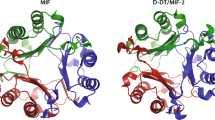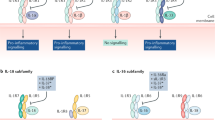Abstract
Members of the Toll-like receptor (TLR) family are key regulators of both innate and adaptive immune responses. The function of TLRs in various human diseases has been investigated by comparison of the incidence of disease among people having different polymorphisms in genes that participate in TLR signaling. These studies have shown that TLR function affects several diseases, including sepsis, immunodeficiencies, atherosclerosis and asthma. As this body of data grows, it will provide new insights into disease pathogenesis as well as valuable information on the merits of various therapeutic options.
This is a preview of subscription content, access via your institution
Access options
Subscribe to this journal
Receive 12 print issues and online access
$209.00 per year
only $17.42 per issue
Buy this article
- Purchase on Springer Link
- Instant access to full article PDF
Prices may be subject to local taxes which are calculated during checkout


Similar content being viewed by others
References
Arbour, N.C. et al. TLR4 mutations are associated with endotoxin hyporesponsiveness in humans. Nat. Genet. 25, 187–191 (2000).
Wenzel, R.P. Anti-endotoxin monoclonal antibodies—a second look. N. Engl. J. Med. 326, 1151–1153 (1992).
Agnese, D.M. et al. Human Toll-like receptor 4 mutations but not CD14 polymorphisms are associated with an increased risk of Gram-negative infections. J. Infect. Dis. 186, 1522–1525 (2002).
Lorenz, E., Mira, J., Frees, K. & Schwartz, D. Relevance of mutations in the TLR4 receptor in patients with Gram negative septic shock. Arch. Int. Med. 162, 1028–1032 (2002).
Child, N.J. et al. Polymorphisms in Toll-like receptor 4 and the systemic inflammatory response syndrome. Biochem. Soc. Trans. 31, 652–653 (2003).
Smirnova, I. et al. Assay of locus-specific genetic load implicates rare Toll-like receptor 4 mutations in meningococcal susceptibility. Proc. Natl. Acad. Sci. USA 100, 6075–6080 (2003).
Read, R.C. et al. A functional polymorphism of Toll-like receptor 4 is not associated with likelihood or severity of meningococcal disease. J. Infect. Dis. 184, 640–642 (2001).
Feterowski, C. et al. Effects of functional Toll-like receptor-4 mutations on the immune response to human and experimental sepsis. Immunology 109, 426–431 (2003).
Lorenz, E., Mira, J., Cornish, K., Arbour, N. & Schwartz, D. A novel polymorphism in the toll-like receptor 2 gene and its potential association with staphylococcal infection. Infect. Immun. 68, 6398–6401 (2000).
Ogus, A.C. et al. The Arg753GIn polymorphism of the human Toll-like receptor 2 gene in tuberculosis disease. Eur. Respir. J. 23, 219–223 (2004).
Bochud, P.Y., Hawn, T.R. & Aderem, A. Cutting edge: a Toll-like receptor 2 polymorphism that is associated with lepromatous leprosy is unable to mediate mycobacterial signaling. J. Immunol. 170, 3451–3454 (2003).
Kang, T.J. & Chae, G.T. Detection of Toll-like receptor 2 (TLR2) mutation in the lepromatous leprosy patients. FEMS Immunol. Med. Microbiol. 31, 53–58 (2001).
Ben-Ali, M., Barbouche, M.R., Bousnina, S., Chabbou, A. & Dellagi, K. Toll-like receptor 2 Arg677Trp polymorphism is associated with susceptibility to tuberculosis in Tunisian patients. Clin. Diagn. Lab. Immunol. 11, 625–6 (2004).
Picard, C. et al. Pyogenic bacterial infections in humans with IRAK-4 deficiency. Science 299, 2076–2079 (2003).
Medvedev, A.E. et al. Distinct mutations in IRAK-4 confer hyporesponsiveness to lipopolysaccharide and interleukin-1 in a patient with recurrent bacterial infections. J. Exp. Med. 198, 521–531 (2003).
Saleh, M. et al. Differential modulation of endotoxin responsiveness by human caspase-12 polymorphisms. Nature 429, 75–79 (2004).
Medvedev, A.E., Lentschat, A., Wahl, L.M., Golenbock, D.T. & Vogel, S.N. Dysregulation of LPS-induced Toll-like receptor 4-MyD88 complex formation and IL-1 receptor-associated kinase 1 activation in endotoxin-tolerant cells. J. Immunol. 169, 5209–5216 (2002).
Escoll, P. et al. Rapid up-regulation of IRAK-M expression following a second endotoxin challenge in human monocytes and in monocytes isolated from septic patients. Biochem. Biophys. Res. Commun. 311, 465–472 (2003).
Hotchkiss, R.S. et al. Sepsis-induced apoptosis causes progressive profound depletion of B and CD4+ T lymphocytes in humans. J. Immunol. 166, 6952–6963 (2001).
Tinsley, K.W. et al. Sepsis induces apoptosis and profound depletion of splenic interdigitating and follicular dendritic cells. J. Immunol. 171, 909–914 (2003).
Bannerman, D.D., Tupper, J.C., Erwert, R.D., Winn, R.K. & Harlan, J.M. Divergence of bacterial lipopolysaccharide pro-apoptotic signaling downstream of IRAK-1. J. Biol. Chem. 277, 8048–8053 (2002).
Bannerman, D.D., Erwert, R.D., Winn, R.K. & Harlan, J.M. TIRAP mediates endotoxin-induced NF-κB activation and apoptosis in endothelial cells. Biochem. Biophys. Res. Commun. 295, 157–162 (2002).
Smahi, A. et al. Genomic rearrangement in NEMO impairs NF-κB activation and is a cause of incontinentia pigmenti. The International Incontinentia Pigmenti (IP) Consortium. Nature 405, 466–472 (2000).
Puel, A., Picard, C., Ku, C.L., Smahi, A. & Casanova, J.L. Inherited disorders of NF-κB-mediated immunity in man. Curr. Opin. Immunol. 16, 34–41 (2004).
Orange, J.S. et al. Deficient natural killer cell cytotoxicity in patients with IKK-γ/NEMO mutations. J. Clin. Invest. 109, 1501–1509 (2002).
Doffinger, R. et al. X-linked anhidrotic ectodermal dysplasia with immunodeficiency is caused by impaired NF-κB signaling. Nat. Genet. 27, 277–285 (2001).
Jain, A. et al. Specific missense mutations in NEMO result in hyper-IgM syndrome with hypohydrotic ectodermal dysplasia. Nat. Immunol. 2, 223–228 (2001).
Courtois, G. et al. A hypermorphic IκBα mutation is associated with autosomal dominant anhidrotic ectodermal dysplasia and T cell immunodeficiency. J. Clin. Invest. 112, 1108–1115 (2003).
Kiechl, S. et al. Toll-like receptor 4 polymorphisms and atherogenesis. N. Engl. J. Med. 347, 185–192 (2002).
Ameziane, N. et al. Association of the Toll-like receptor 4 gene Asp299Gly polymorphism with acute coronary events. Arterioscler. Thromb. Vasc. Biol. 23, e61–64 (2003).
Boekholdt, S.M. et al. Variants of toll-like receptor 4 modify the efficacy of statin therapy and the risk of cardiovascular events. Circulation 107, 2416–2421 (2003).
Leinonen, M. & Saikku, P. Evidence for infectious agents in cardiovascular disease and atherosclerosis. Lancet Infect. Dis. 2, 11–17 (2002).
Bulut, Y. et al. Chlamydial heat shock protein 60 activates macrophages and endothelial cells through Toll-like receptor 4 and MD2 in a MyD88-dependent pathway. J. Immunol. 168, 1435–1440 (2002).
Bjorkbacka, H. et al. Reduced atherosclerosis in MyD88-null mice links elevated serum cholesterol levels to activation of innate immunity signaling pathways. Nat. Med. 10, 416–421 (2004).
Xu, X.H. et al. Toll-like receptor-4 is expressed by macrophages in murine and human lipid-rich atherosclerotic plaques and upregulated by oxidized LDL. Circulation 104, 3103–3108 (2001).
Eriksson, U. et al. Dendritic cell-induced autoimmune heart failure requires cooperation between adaptive and innate immunity. Nat. Med. 9, 1484–1490 (2003).
Michel, O. et al. Severity of asthma is related to endotoxin in house dust. Am. J. Respir. Crit. Care Med. 154, 1641–1646 (1996).
Michel, O., Duchateau, J. & Sergysels, R. Effect of inhaled endotoxin on bronchial reactivity in asthmatic and normal subjects. J. Appl. Physiol. 66, 1059–1064 (1989).
Braun-Fahrlander, C. et al. Environmental exposure to endotoxin and its relation to asthma in school-age children. N. Engl. J. Med. 347, 869–877 (2002).
Gehring, U., Bischof, W., Fahlbusch, B., Wichmann, H.E. & Heinrich, J. House dust endotoxin and allergic sensitization in children. Am. J. Respir. Crit. Care Med. 166, 939–944 (2002).
Raby, B.A. et al. Polymorphisms in toll-like receptor 4 are not associated with asthma or atopy-related phenotypes. Am. J. Respir. Crit. Care Med. 166, 1449–1456 (2002).
Werner, M. et al. TLR4 gene variants modify endotoxin effects on asthma. J. Allergy Clin. Immunol. 112, 323–330 (2003).
Yang, I.A. et al. Toll-like receptor 4 polymorphism and severity of atopy in asthmatics. Genes Immun. 5, 41–45 (2004).
Higgins, S.C. et al. Toll-like receptor 4-mediated innate IL-10 activates antigen-specific regulatory T cells and confers resistance to Bordetella pertussis by inhibiting inflammatory pathology. J. Immunol. 171, 3119–3127 (2003).
Caramalho, I. et al. Regulatory T cells selectively express toll-like receptors and are activated by lipopolysaccharide. J. Exp. Med. 197, 403–411 (2003).
Donnelly, J.J., Deck, R.R. & Liu, M.A. Immunogenicity of a Haemophilus influenzae polysaccharide-Neisseria meningitidis outer membrane protein complex conjugate vaccine. J. Immunol. 145, 3071–3079 (1990).
Latz, E., Franko, J., Golenbock, D.T. & Schreiber, J.R. Haemophilus influenzae type b-outer membrane protein complex glycoconjugate vaccine induces cytokine production by engaging human toll-like receptor 2 (TLR2) and requires the presence of TLR2 for optimal immunogenicity. J. Immunol. 172, 2431–2438 (2004).
Jiang, W. & Pisetsky, D.S. Enhancing immunogenicity by CpG DNA. Curr. Opin. Mol. Ther. 5, 180–185 (2003).
Kadowaki, N. et al. Subsets of human dendritic cell precursors express different toll-like receptors and respond to different microbial antigens. J. Exp. Med. 194, 863–869 (2001).
Hahn, B.H. Antibodies to DNA. N. Engl. J. Med. 338, 1359–1368 (1998).
Gursel, I. et al. Repetitive elements in mammalian telomeres suppress bacterial DNA-induced immune activation. J. Immunol. 171, 1393–1400 (2003).
Leadbetter, E.A. et al. Chromatin-IgG complexes activate B cells by dual engagement of IgM and Toll-like receptors. Nature 416, 603–607 (2002).
Viglianti, G.A. et al. Activation of autoreactive B cells by CpG dsDNA. Immunity 19, 837–847 (2003).
Acknowledgements
Supported by the National Institute of Environmental Health Sciences (ES11375, ES07498, ES012496 and ES011961), the National Heart Lung and Blood Institute (HL66604 and HL66611) and the Department of Veterans' Affairs (Merit Review).
Author information
Authors and Affiliations
Corresponding author
Ethics declarations
Competing interests
The authors declare no competing financial interests.
Rights and permissions
About this article
Cite this article
Cook, D., Pisetsky, D. & Schwartz, D. Toll-like receptors in the pathogenesis of human disease. Nat Immunol 5, 975–979 (2004). https://doi.org/10.1038/ni1116
Published:
Issue Date:
DOI: https://doi.org/10.1038/ni1116
This article is cited by
-
Different expression patterns of inflammatory cytokines induced by lipopolysaccharides from Escherichia coli or Porphyromonas gingivalis in human dental pulp stem cells
BMC Oral Health (2022)
-
Hepatic Protective Effects of Jujuboside B through the Modulation of Inflammatory Pathways
Biotechnology and Bioprocess Engineering (2022)
-
Diagnostic Modalities in Primary Immunodeficiency
Clinical Reviews in Allergy & Immunology (2022)
-
TRAF6-mediated ubiquitination of MST1/STK4 attenuates the TLR4-NF-κB signaling pathway in macrophages
Cellular and Molecular Life Sciences (2021)
-
Toll-Like Receptors, Infections, and Rheumatoid Arthritis
Clinical Reviews in Allergy & Immunology (2020)



